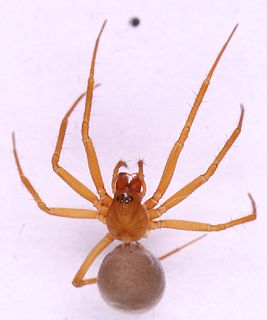 W
WAllomengea is a genus of dwarf spiders that was first described by Embrik Strand in 1912.
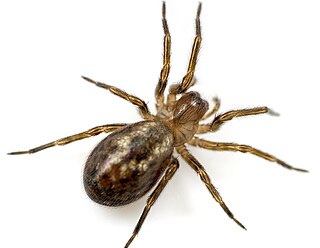 W
WAmaurobius similis is a species of spider in the family Amaurobiidae.
 W
WAphileta is a genus of dwarf spiders that was first described by J. E. Hull in 1920. As of May 2019 it contains only three species in the United States and Canada: A. centrasiatica, A. microtarsa, and A. misera.
 W
WThe spider species Araneus diadematus is commonly called the European garden spider, diadem spider, orangie, cross spider and crowned orb weaver. It is sometimes called the pumpkin spider, although this name is also used for a different species, Araneus marmoreus. It is an orb-weaver spider found in Europe and North America.
 W
WArctobius is a genus of tangled nest spiders containing the single species, Arctobius agelenoides. It was first described by Pekka T. Lehtinen in 1967, with a holarctic distribution.
 W
WBaryphyma is a genus of dwarf spiders that was first described by Eugène Louis Simon in 1884.
 W
WCanalidion is a monotypic genus of tangle-web spiders containing the single species, Canalidion montanum. The species was first described by James Emerton in 1882 under the name Theridion montanum. J. Wunderlich moved it to its own genus in 2018, because it had more teeth on the anterior margin of the cheliceral furrow, a basal depression of the cymbium, and an embolus positioned dorsally. It has a holarctic distribution.
 W
WCeraticelus is a genus of dwarf spiders that was first described by Eugène Louis Simon in 1884.
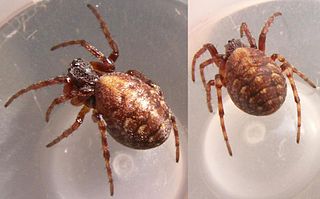 W
WCercidia is a genus of orb-weaver spiders first described by Tamerlan Thorell in 1869. As of April 2019 it contains only three species.
 W
WClubiona trivialis is a small reddish brown spider with holarctic distribution. It is found in exposed places on low vegetation. Adults can be found throughout the year.
 W
WCryphoeca is a genus of araneomorph spiders in the family Cybaeidae, and was first described by Tamerlan Thorell in 1870. The name means hidden, in reference to its preference for hiding under loose bark or in stone walls.
 W
WCyclosa conica is a small spider with no common name. It is an orb weaver, and it is easily recognized by the way it strings together the dead bodies of insects and other debris and hangs it near the center of its web. It hides on this string of debris, and its natural coloration makes it extremely difficult to see until it moves. One of its defenses against predators is to blend in with this debris and to feign death when disturbed. These spiders are small; the females range from 5.3 mm to 7.5 mm, and the males range from 3.6 mm to 4 mm.
 W
WDictyna arundinacea is a species of spider belonging to the family Dictynidae. It has a holarctic distribution; It is found throughout Britain and northern Europe.
 W
WDiplostyla is a monotypic genus of dwarf spiders containing the single species, Diplostyla concolor. It was first described by James Henry Emerton in 1882, and has only been found in Russia, and Turkey.
 W
WEnoplognatha thoracica is a spider species with Holarctic distribution. It is notably found in Lithuania.
 W
WThe filmy dome spider is a sheet weaver: a spider in the family Linyphiidae with a holarctic distribution. These spiders construct a dome of fine silk and hang upside-down under it, waiting for their prey.
 W
WGnaphosa borea is a ground spider species with Holarctic distribution. It is found in boreal forests in Russia, in the United States and in Canada.
 W
WGnaphosa muscorum is a ground spider species with Holarctic distribution. The subspecies G. muscorum gaunitzi is found in Sweden and Russia.
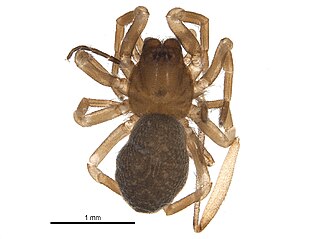 W
WHackmania is a genus of cribellate araneomorph spiders in the family Dictynidae, and was first described by Pekka T. Lehtinen in 1967. As of May 2019 it contains only two species: H. prominula and H. saphes.
 W
WHelophora is a genus of dwarf spiders that was first described by Anton Menge in 1866.
 W
WIslandiana is a genus of dwarf spiders that was first described by J. Braendegaard in 1932.
 W
WLarinioides cornutus, the furrow spider, furrow orb spider, or foliate spider is an orb-weaver spider with Holarctic distribution.
 W
WLarinioides sclopetarius, commonly called bridge spider or gray cross spider, is a relatively large orb-weaver spider with holarctic distribution that is often found on bridges, especially near light and over water. The species tends to live on steel objects and is seldom seen on vegetation.
 W
WLasaeola prona is a tangle web spider species with Holarctic distribution. It is notably found in Lithuania.
 W
WMicaria pulicaria, the glossy ant spider, is a species of ground spider from the family Gnaphosidae with a Holarctic distribution.
 W
WMicrolinyphia pusilla is a species of spider belonging to the family Linyphiidae. It has a Holarctic distribution.
 W
WMisumena vatia is a species of crab spider with holarctic distribution. In North America, it is called the goldenrod crab spider or flower (crab) spider It is commonly found hunting in goldenrod sprays in the autumn. Young males in the early summer may be quite small and easily overlooked, but females can grow up to 10 mm (0.39 in) ; males reach 5 mm (0.20 in) at most.
 W
WNeriene montana is a species of spider belonging to the family Linyphiidae. With a holarctic distribution, it is found throughout northern Europe.
 W
WNeriene peltata is a species of spider belonging to the family Linyphiidae. It has a Holarctic distribution.
 W
WOhlertidion is a genus of comb-footed spiders that was first described by J. Wunderlich in 2008. As of September 2019 it contains three species with a holarctic distribution, including Greenland: O. lundbecki, O. ohlerti, and O. thaleri. A 2019 genetic study proposed to synonymize this genus with Heterotheridion; however, the evidence was based predominantly on COI barcoding, which is a useful tool for separating species, but is less useful for determining higher taxa.
 W
WOzyptila praticola is a species of crab spider found throughout Europe and the Middle East. Females reach up to 4 mm, males grow up to 3 mm. Both sexes are of a dark reddish brown. It hunts primarily in the undergrowth, but can also be found under the bark or on the lower branches of trees. This is also where the female deposits and guards its egg sac. Adults can be found most of the year.
 W
WPhylloneta is a genus of comb-footed spiders formerly considered a sub-genus of Allotheridion, and raised to genus status in 2008. The type species was first described by Eugen von Keyserling in 1884 as Theridion pictipes. As of September 2019 it contains three species and two subspecies with a holarctic distribution: P. impressa, P. pictipes, P. sisyphia, P. s. foliifera, and P. s. torandae.
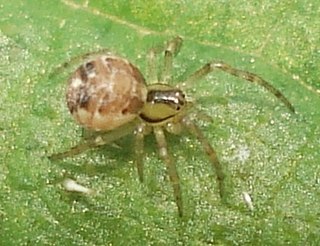 W
WPhylloneta impressa is a species of comb-footed spider from the genus Phylloneta with a Holarctic distribution.
 W
WPlatnickina tincta is a tangle web spider species with Holarctic distribution. It is notably found in Lithuania.
 W
WSteatoda bipunctata is a species of cob-web spider, of the genus Steatoda, in the family Theridiidae.
 W
WTetragnatha extensa is a species of spider found across the Northern Hemisphere. It has an elongate body, up to 11 mm (0.43 in) long, and adopts a straight line posture when alarmed. It lives on low vegetation in damp areas, and feeds on flying insects which it catches in its web.
 W
WThanatus formicinus is a species of spider in the family Philodromidae. It has a Holarctic distribution.
 W
WTheridiosoma gemmosum is a species of spider in the family Theridiosomatidae, known as ray spiders. It is widely distributed in the Holarctic region. A small spider with a shiny globular abdomen, it constructs a conical orb web.
 W
WTibellus oblongus is a spider with a Holarctic distribution.
 W
WTitanoeca nivalis is a species of araneomorph spider in the family Titanoecidae. It has a Holarctic distribution.
 W
WTrochosa terricola is known as the ground wolf spider, is a wolf spider which is common and widespread in western and central Europe. It has been recorded as prey for the pompilid wasp.
 W
WWalckenaeria vigilax is a spider species with Holarctic distribution. It is considered new to the fauna of Latvia since 2009.
 W
WYunohamella is a genus of comb-footed spiders that was first described by H. Yoshida in 2007.
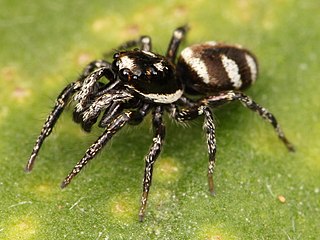 W
WThe zebra spider is a common jumping spider of the Northern Hemisphere. Like other jumping spiders it does not build a web. It has a particularly large pair of forward facing eyes that help it to locate and stalk its prey before pouncing on it. Their common name refers to their vivid black-and-white colouration, whilst their scientific name derives from Salticus from the Latin for “dancing”, in reference to their agility, and the Greek scenicus, translating to “theatrical” or “of a decorative place,” in reference to the flashy, zebra-like coloration of the species.
 W
WZygiella x-notata, sometimes known as the missing sector orb weaver or the silver-sided sector spider, is a spider species in the family Araneidae. They are solitary spiders, residing in daily-spun orb webs. Z. x-notata are a member of the genus Zygiella, the orb-weaving spiders. The adult female is easily recognized by the characteristic leaf-like mark on her posterior opisthosoma, caudal to the yellow-brown cephalothorax.